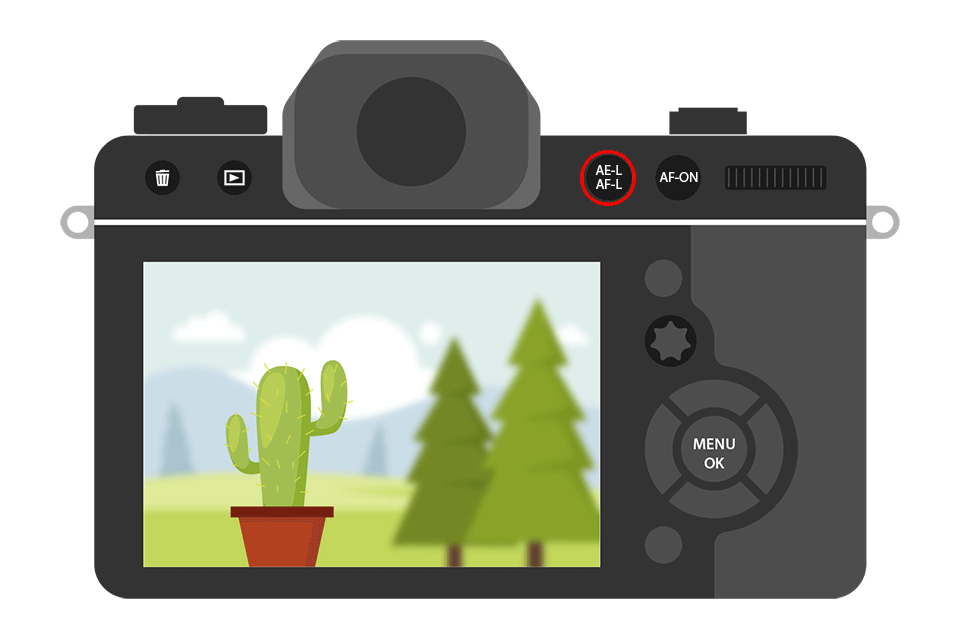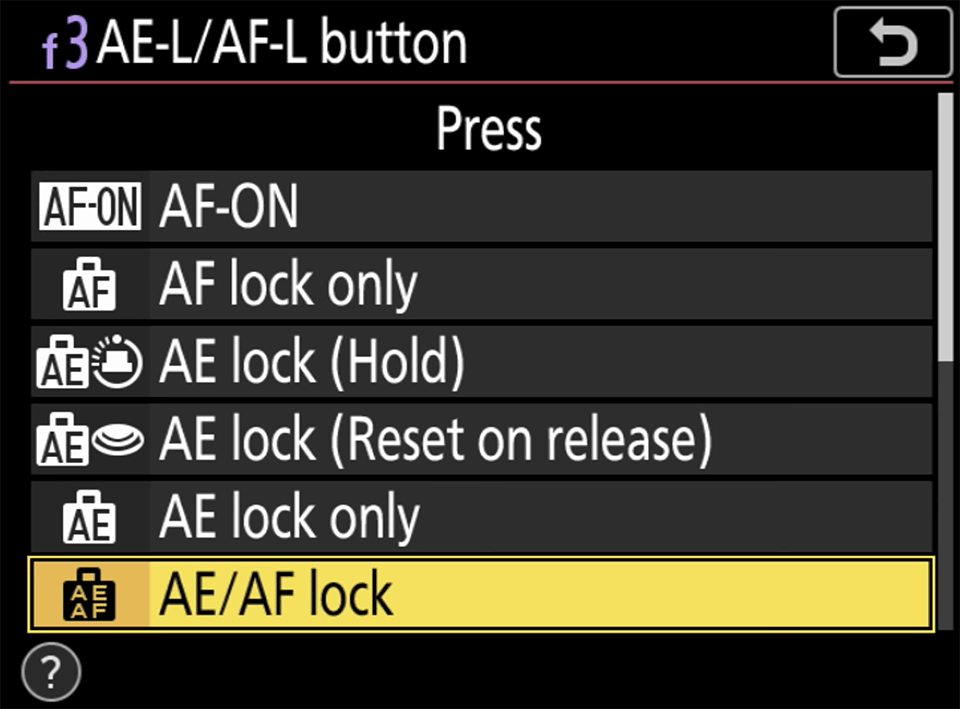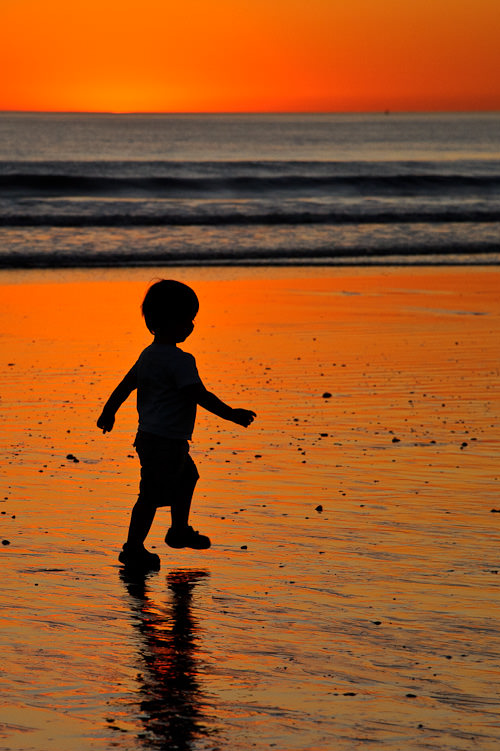What Does Af Mean On A Camera
Whether you are using a DSLR or a mirrorless photographic camera, the might be a special button on the dorsum of it labeled "AEL" or "AE-Fifty / AF-L" (in the instance of Nikon) that can be quite useful in many situations. In this article, I will explain what the AE-Fifty / AF-L button does, when information technology should be used, and how it tin can be combined with different autofocus modes. I volition also demonstrate how I personally employ this push on my cameras when I ready them up.

AutoExposure-Lock / AutoFocus-Lock
The AE-L / AF-L button stands for "AutoExposure-Lock and AutoFocus-Lock" and its primary role is to lock camera exposure and/or focus. What does this exactly hateful? If you are using any of the camera modes like Plan, Aperture Priority, Shutter Priority, or other scene modes, the button could be used to force the camera to use a certain value for shutter speed, discontinuity, ISO, and white remainder. Since in whatsoever of the automatic modes the camera uses its metering sensor to make up one's mind the optimal exposure, instead of having your camera re-evaluate the low-cal every time you recompose, you could lock the exposure to a value yous are comfy with – hence the term "AutoExposure-Lock". There are many cases where using this feature is very helpful.
1 example is when you photo panoramas. It is extremely important to use exactly the same exposure from frame to frame in panoramic photography. If 1 exposure differs from another, it is practically impossible for panoramic software to sew together images together in a consistent, continuous grade. Some other good case is if you lot are photographing a subject with a constantly irresolute groundwork and you desire to expose the subject exactly the same fashion from shot to shot. Basically, any fourth dimension consistency of exposure is required and you practise not desire to switch to a total manual mode, the AE-L button can exist very useful.
What about AutoFocus-Lock (AF-L)? Similar to exposure lock, autofocus lock tin be used to stop the photographic camera from making the lens reacquire focus when you lot recompose. For example, if you lot are photographing indoors in a dim environment, y'all volition find that using the center focus indicate is going to give you the virtually authentic results. This is because the center focus signal is ever the most authentic, particularly on entry-level DSLRs that only have one cross-type sensor. And then if you lot want to use the center focus point to acquire focus, it does non always mean that you want to position your subject field in the center. Equally soon equally you recompose your shot and half-press the shutter push once more, the camera will be forced to reacquire focus. If you shoot in "AF-S" or "Unmarried Area Focus Style", yous could continue half-pressing the shutter button without releasing information technology when recomposing your shot, which would not force the camera to reacquire focus.
However, if the photographic camera is set to "AF-C" or "Continuous Focus Mode", then the camera will ever continuously reacquire focus when you half-press the shutter push and recompose your shot. And so if you lot do not desire to bargain with these situations, you could use the AutoFocus-Lock feature of the camera to lock the focus on your subject field, so you could recompose the shot and take a moving-picture show. The focus volition remain on your subject area and will non change, every bit long as you proceed to concur the button. Please note that you accept to be careful when recomposing shots like this because the focus plane that is parallel to the camera sensor changes, which will oftentimes result in bad focus when using large apertures.
Default AE-L / AF-L Behavior
The default behavior of the AE-L / AF-Fifty button is typically set to lock both camera exposure and focus. Entry-level DSLRs typically have limited control over this button'due south functionality, while pro-level DSLRs have many ways to command the behavior of the AE-L / AF-L button. For example, the Nikon D3400 only has five options for this button: AF / AE lock, AE lock just, AF lock only, AE lock (agree), and AF-ON (see more on these below), while Nikon D500 has all of these, plus 12 more means to control the button'due south behavior. So the number of ways to customize the AE-L / AF-Fifty button will depend on the camera model.
Types of AutoExposure and AutoFocus Lock Modes
You might be confused when y'all meet the dissimilar types of AE and AF options in the camera menu. Which one does what and what should yous set yours to? Let'south go over each i, but offset, go to your camera menu and Navigate "Custom Setting Menu"->"Controls"->"Assign AE-L/AF-L button" or to "Setup Carte"->"Buttons" on some entry-level Nikon DSLRs:

You lot should run into some or all of the below:
- AE/AF lock – the default behavior of the AE-L/AF-L button. Will lock both camera exposure (shutter speed, aperture, ISO, and white balance) and lens focus. The characteristic will only be active while you hold down the button. One time you lot release it, the lock will be released every bit well.
- AE lock only – will only lock the camera exposure, so focus will be reacquired if you recompose the shot. Likewise just works while you concur downwardly the AE-50/AF-Fifty push.
- AE lock (Reset on release) – exposure will be locked in one case you press the AE-L/AF-50 push and will stay locked until you take a pic, even if you release it.
- AE lock (Hold) – exposure will exist locked when the button is pressed and will stay locked even if you take multiple pictures. The lock volition exist automatically removed if the camera is inactive for a time period set in the "Auto meter-off filibuster" menu setting, or can exist likewise removed by pressing the AE-Fifty/AF-50 push again.
- AF lock only – only focus will exist locked while the button is depressed. The lock is removed as soon every bit y'all release the button.
Delight note that when the AE-L / AF-L is depressed and the camera is set to any of the AE modes, you will see an "AE-L" indicator in your viewfinder. If you ready it to "AF lock only", the indicator will not calorie-free upward.
You might also find many other options under "Assign AE-L/AF-L button" such as "FV Lock", "Live View", etc. I won't get over these, since these options depend on your camera and will also modify the functionality of the AE-L / AF-L button. The only choice I volition mention, is "AF-ON", because information technology is a very useful feature on entry-level DSLRs like Nikon D3x00 and D5x00-serial cameras. Since entry-level DSLRs do not have a dedicated autofocus "AF-ON" button, you can fix the AE-50 / AF-Fifty button to acquire focus instead (which will de-activate focus acquisition when you half-press the shutter release). That fashion, you can larn focus with the AE-50 / AF-50 button and take pictures with the shutter release. Then, you don't accept to worry virtually locking your focus when you recompose, since half-pressing the shutter release button will practice nothing.
So, which lock mode exercise I personally apply and why? When I use an entry-level DSLR, I either choose "AE/AF lock", and then that both exposure and focus stay locked together, or I ready the button to "AF-ON" and use transmission mode to proceed my exposure consistent. On higher-terminate DSLRs with a defended "AF-ON" button, I always choose "AE lock (Hold)", then that just the exposure is locked – the photographic camera volition not automatically reacquire focus when the "AF-ON" push button is activated. I use this feature quite a chip when taking panoramic shots and I like the fact that the exposure stays locked while I take pictures. Once I am done, I either press the button again or let the lock fourth dimension out. Turning the camera off besides releases the lock. Oh, and if you happen to change your camera mode from say Aperture Priority to Shutter Priority or to Program, the exposure values will stay locked.
Exposure Lock and Metering
You might wonder about how to properly meter your photographic camera before even locking the exposure. If you are dislocated about metering, I highly recommend checking out my "agreement metering modes" commodity, where I go through dissimilar types of camera metering modes in item. Determining the correct exposure is relatively easy nowadays with modern DSLRs, because cameras are equipped with complex metering systems that apply diverse algorithms and preloaded templates to accurately set exposure values. On tiptop of that, plenty of options to control and fine-tune the exposure are provided to cease-users – different metering modes tin can control the way exposure is evaluated by the photographic camera, while exposure compensation can be used to override the calculated exposure.
Let me give you an case of how you tin can combine camera modes, metering modes, autofocus modes, and autoexposure lock to take a movie. Say I am photographing my son at sunset on a embankment, with the dominicus behind him and me in forepart of him. I am in Aperture Priority mode, where I gear up the discontinuity and my camera automatically calculates the shutter speed. I normally utilise Matrix Metering" mode, then the camera virtually likely would expose the background correctly, while my son becomes a silhouette (because the groundwork is much brighter):

So if I wanted to betrayal my son correctly without worrying well-nigh bravado out the background, I would switch to Spot Metering mode and position the focus point on his face. The camera would so meter off his confront instead, exposing him properly and not paying attention to the background. If I take a picture and he is still underexposed, I would dial positive exposure compensation to farther burnish him up or if he is overexposed, I would dial negative exposure bounty. Once my exposure looks good, I would press the "AE-L / AF-L" button on the photographic camera (which is set to "AE lock agree") to lock the exposure and continue taking pictures without worrying about setting the exposure again. If he constantly moves while I take pictures, I would choice Continuous Autofocus Mode (AF-C) to track his motion.
Remember, all these tools are given to us to simplify our photography so that we tin can concentrate more on capturing bang-up images, rather than worrying about properly calculating the exposure. Once yous learn how to use these dissimilar modes and features, you lot will be able to capture images the way you want to with ease.
Hope you detect the higher up commodity useful. Let me know if you have any questions!
Source: https://photographylife.com/nikon-ae-l-af-l-button
Posted by: blackwellcrientic.blogspot.com


0 Response to "What Does Af Mean On A Camera"
Post a Comment